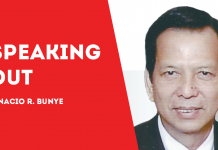[av_one_full first min_height=” vertical_alignment=” space=” custom_margin=” margin=’0px’ padding=’0px’ border=” border_color=” radius=’0px’ background_color=” src=” background_position=’top left’ background_repeat=’no-repeat’ animation=”]
[av_heading heading=’MY SPIN ‘ tag=’h3′ style=’blockquote modern-quote’ size=” subheading_active=’subheading_below’ subheading_size=’15’ padding=’10’ color=” custom_font=”]
BY JUN ESCALONA
[/av_heading]
[av_textblock size=” font_color=” color=”]
The origins of methamphetamine
METHAMPHETAMINE is not a new drug, although it has become more powerful in recent years as techniques for its manufacture have evolved.
Amphetamine was first made in 1887 in Germany and methamphetamine, more potent and easy to make, was developed in Japan in 1919. The crystalline powder was soluble in water, making it a perfect candidate for injection.
Methamphetamine went into wide use during World War II; it was used to keep troops awake. High doses were given to Japanese Kamikaze pilots before their suicide missions. And after the war, methamphetamine abuse by injection reached epidemic proportions when supplies stored for military use became available to the Japanese public.
In the 1950s, methamphetamine was prescribed as a diet aid and to fight depression. Easily available, it was used as a nonmedical stimulant by college students, truck drivers and athletes, and abuse of the drug spread.
This pattern changed markedly in the 1960s with the increased availability of injectable methamphetamine, worsening the abuse.
In 1970, the US government made it illegal for most uses. After that, American motorcycle gangs controlled most of the production and distribution of the drug. Most users at the time lived in rural communities and could not afford the more expensive cocaine.
In the 1990s, Mexican drug trafficking organizations set up large laboratories in California. While these massive labs were able to generate 50 pounds of the substance in a single weekend, smaller private labs sprung up in kitchens and apartments, earning the drug one of its names, “stove top.”
From there it spread across the United States and into Europe, through the Czech Republic. Today, most of the drug available in Asia is produced in Thailand, Myanmar and China.
Drugs are essentially poisons. The amount taken determines the effect. A small amount acts as a stimulant (speeds you up). A greater amount acts as a sedative (slows you down). Larger amounts poison and can kill. This is true of any drug. Only the amount needed to achieve the effect differs.
But many drugs have another liability: they directly affect the mind. They can distort the user’s perception of what is happening around him or her. As a result, the person’s actions may be odd, irrational, inappropriate, and even destructive.
Drugs block off all sensations, the desirable ones with the unwanted. So, while providing short-term help in the relief of pain, they also wipe out ability and alertness and muddle one’s thinking.
Medicines are intended to speed up or slow down or change something about the way your body is working, to try to make it work better. Sometimes they are necessary. But they act as stimulants or sedatives, and too much can kill you. So if you do not use medicines as they are supposed to be used, they can be as dangerous as illegal drugs.
The real answer is to get the facts and not to take drugs in the first place.
People take drugs because they want to change something in their lives. Here are some of the reasons young people have given for taking drugs – to fit in; to escape or relax; to relieve boredom; to seem grown up; to rebel; to experiment.
They think drugs are a solution. But eventually, the drugs become the problem.
Difficult as it may be to face one’s problems, the consequences of drug use are always worse than the problem one is trying to solve with them. The real answer is to get the facts and not to take drugs in the first place.
Shabu is the term for crystal meth in the Philippines. It is the drug of choice of 90 percent of the Filipino drug users. Shabu is commonly made from cheap medicines containing ephedrine.
Police in the Philippines say shabu is often made in industrial-style labs capable of producing over one ton per day.
Shabu is a considerably cheap drug. A precinct located in the country was given a surprise drug test. Ultimately 69 percent of the people tested positive for drug use, mainly shabu. Because it is such a popular drug of choice in the Philippines, it is important for people to recognize warning signs of use and understand that there is help available.
In Antique, dozens have been arrested by the police in buy-bust operations mandated by President Duterte’s campaign for a drug-free Philippines. Most dramatic is the arrest of a public school teacher and her son in northern Antique in the sale of meth to a police poseur buyer.
Police authorities are now facing a problem of accommodation of drug personalities – user or pusher – arrested in their operations.
However there are stories of abnormal mode of arrests by authorities implementing the anti-drug operations in the province, for reasons of chalking an impressive record, since it is said that lackluster performance could result in negative impressions in the hierarchy of officialdom.
In Valderrama town, there is this story of a worker harvesting palay in a neighbor’s field; he was called by some men in the road only to be handcuffed. Fearing something could happen because the men wore masks, the rice harvester ran to the police only to find out the masked men were also policemen of the anti-illegal drugs task group. Why they have to hide their identity escapes reason.
Most people think this is a violation of the unwritten rule of transparency in official transactions, and should not be allowed to continue.
Another young student from a local university in the north was called by some policemen to be given some few bills of money but he refused, so the police left the money on top of a motorcycle and went to fetch their patrol vehicle. The vehicle carried a small table where more money bills were placed, ostensibly made to appear that those were marked money used in a buy-bust operation.
Fortunately for the supposed victim of abuse, or unfortunately for the policemen, many witnessed the episode and some observers documented the activity with their mobile phone video cams.
But these are allegations and will remain as such until proven true.
Shabu addiction will destroy a user’s life, and everyone involved in it. It is important that a user gets treatment at a rehab center.
However, in the same vein, an irresponsible approach to the problem, just like the idea of masked policemen making arrests, will surely aggravate the problem. We can only hope that authorities would implement more responsive methods of arrests, following the age-old tradition of presuming innocence until proven guilty./PN
[/av_textblock]
[/av_one_full]







